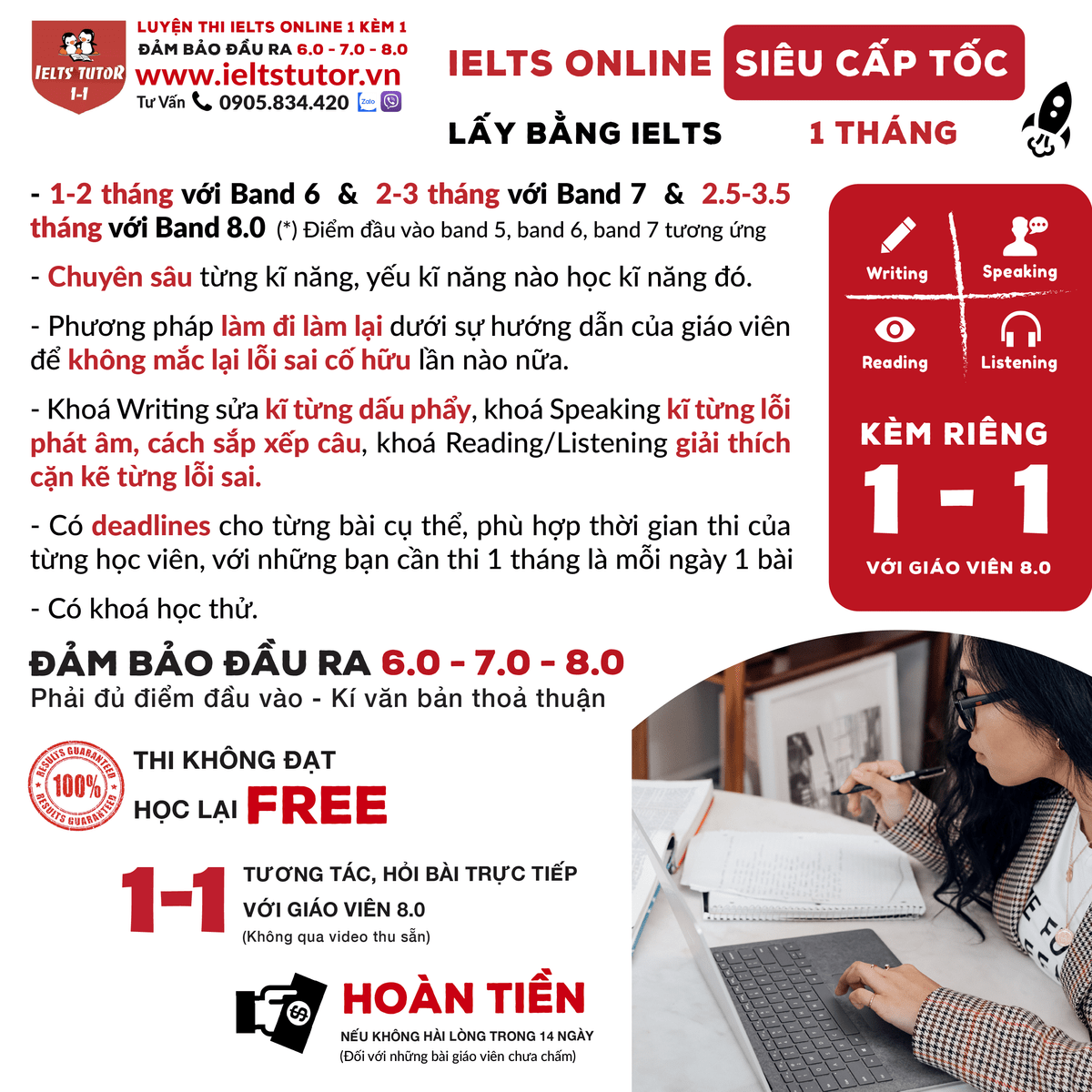IELTS TUTOR cung cấp 🔥Painters of Time: Đề thi thật IELTS READING (IELTS Reading Recent Actual Test) - Làm bài online format computer-based, , kèm đáp án, dịch & giải thích từ vựng - cấu trúc ngữ pháp khó & GIẢI ĐÁP ÁN VỚI LOCATION bên cạnh đó thí sinh có thể tham khảo CẦN VIẾT & THU ÂM BAO NHIÊU BÀI ĐỂ ĐẠT 8.0 SPEAKING & 7.0 WRITING?
I. Kiến thức liên quan
II. Làm bài online (kéo xuống cuối bài blog để xem giải thích từ vựng & cấu trúc cụ thể hơn)
III. Painters of Time: Đề thi thật IELTS READING (IELTS Reading Recent Actual Test)
Painters of Time
'The world's fascination with the mystique of Australian Aboriginal art.'
Emmanuel de Roux
A
The works of Aboriginal artists are now much in demand throughout the world, and not just in Australia, where they are already fully recognised: the National Museum of Australia, which opened in Canberra in 2001, designated 40% of its exhibition space to works by Aborigines. In Europe their art is being exhibited at a museum in Lyon, France, while the future Quai Branly museum in Paris – which will be devoted to arts and civilisations of Africa, Asia, Oceania and the Americas – plans to commission frescoes by artists from Australia.>> Form đăng kí giải đề thi thật IELTS 4 kĩ năng kèm bài giải bộ đề 100 đề PART 2 IELTS SPEAKING quý đang thi (update hàng tuần) từ IELTS TUTOR
B
Their artistic movement began about 30 years ago, but its roots go back to time immemorial. All the works refer to the founding myth of the Aboriginal culture, ‘the Dreaming’. That internal geography, which is rendered with a brush and colours, is also the expression of the Aborigines' long quest to regain the land which was stolen from them when Europeans arrived in the nineteenth century. ‘Painting is nothing without history,’ says one such artist, Michael Nelson Tjakamarra.
C
There are now fewer than 400,000 Aborigines living in Australia. They have been swamped by the country's 17.5 million immigrants. These original ‘natives’ have been living in Australia for 50,000 years, but they were undoubtedly maltreated by the newcomers. Driven back to the most barren lands or crammed into slums on the outskirts of cities, the Aborigines were subjected to a policy of ‘assimilation’, which involved kidnapping children to make them better ‘integrated’ into European society, and herding the nomadic Aborigines by force into settled communities.
D
It was in one such community, Papunya, near Alice Springs, in the central desert, that Aboriginal painting first came into its own. In 1971, a white schoolteacher, Geoffrey Bardon, suggested to a group of Aborigines that they should decorate the school walls with ritual motifs, so as to pass on to the younger generation the myths that were starting to fade from their collective memory. He gave them brushes, colours and surfaces to paint on cardboard and canvases. He was astounded by the result. But their art did not come like a bolt from the blue: for thousands of years Aborigines had been ‘painting’ on the ground using sands of different colours, and on rock faces. They had also been decorating their bodies for ceremonial purposes. So there existed a formal vocabulary.
E
This had already been noted by Europeans. In the early twentieth century, Aboriginal communities brought together by missionaries in northern Australia had been encouraged to reproduce on tree bark the motifs found on rock faces. Artists turned out a steady stream of works, supported by the churches, which helped to sell them to the public, and between 1950 and 1960 Aboriginal paintings began to reach overseas museums. Painting on bark persisted in the north, whereas the communities in the central desert increasingly used acrylic paint, and elsewhere in Western Australia women explored the possibilities of wax painting and dyeing processes, known as ‘batik’.
F
What Aborigines depict are always elements of the Dreaming, the collective history that each community is both part of and guardian of. The Dreaming is the story of their origins, of their ‘Great Ancestors’, who passed on their knowledge, their art and their skills (hunting, medicine, painting, music and dance) to man. ‘The Dreaming is not synonymous with the moment when the world was created,’ says Stephane Jacob, one of the organisers of the Lyon exhibition. ‘For Aborigines, that moment has never ceased to exist. It is perpetuated by the cycle of the seasons and the religious ceremonies which the Aborigines organise. Indeed the aim of those ceremonies is also to ensure the permanence of that golden age. The central function of Aboriginal painting, even in its contemporary manifestations, is to guarantee the survival of this world. The Dreaming is both past, present and future.’
G
Each work is created individually, with a form peculiar to each artist, but it is created within and on behalf of a community who must approve it. An artist cannot use a ‘dream’ that does not belong to his or her community, since each community is the owner of its dreams, just as it is anchored to a territory marked out by its ancestors, so each painting can be interpreted as a kind of spiritual road map for that community.
H
Nowadays, each community is organised as a cooperative and draws on the services of an art adviser, a government-employed agent who provides the artists with materials, deals with galleries and museums and redistributes the proceeds from sales among the artists.
I
Today, Aboriginal painting has become a great success. Some works sell for more than $25,000, and exceptional items may fetch as much as $180,000 in Australia.
'By exporting their paintings as though they were surfaces of their territory, by accompanying them to the temples of western art. the Aborigines have redrawn the map of their country, into whose depths they were exiled,* says Yves Le Fur. of the Quai Branlv museum. ‘Masterpieces have been created. Their undeniable power prompts a dialogue that has proved all too rare in the history of contacts between the two cultures’.
Questions 1-6
Reading Passage 3 has nine paragraphs A-I.
Choose the most suitable heading for paragraphs A-F from the list of headings below.
Write the correct number (i-viii) in boxes 1-6 on your answer sheet.
List of Headings
i. Amazing results from a project
ii. New religious ceremonies
iii. Community art centres
iv. Early painting techniques and marketing systems
v. Mythology and history combined
vi. The increasing acclaim for Aboriginal art
vii. Belief in continuity
viii. Oppression of a minority people
Paragraph A
Paragraph B
Paragraph C
Paragraph D
Paragraph E
Paragraph F
Questions 7-10
Complete the flow chart below.
Choose NO MORE THAN THREE WORDS from the passage for each answer.
Write your answers in boxes 7-10 on your answer sheet.
For 7 ______, Aborigines produced ground and rock paintings.
Early twentieth century: churches first promoted the use of 8 ______ for paintings.
Mid-twentieth century: Aboriginal paintings were seen in 9 ______.
Early 1970s: Aborigines painted traditional patterns on 10 ______ in one community.
Questions 11-13
Choose the correct answer, A, B, C or D.
Write your answers in boxes 11-13 on your answer sheet.
In Paragraph G, the writer suggests that an important feature of Aboriginal art is
A. its historical context.
B. its significance to the group.
C. its religious content.
D. its message about the environment.In Aboriginal beliefs, there is a significant relationship between
A. communities and lifestyles.
B. images and techniques.
C. culture and form.
D. ancestors and territory.In Paragraph I, the writer suggests that Aboriginal art invites Westerners to engage with
A. the Australian land.
B. their own art.
C. Aboriginal culture.
D. their own history.
IV. Dịch bài đọc Painters of Time
Painters of Time
'Sự mê hoặc của thế giới đối với nét huyền bí của nghệ thuật thổ dân Úc.'
Emmanuel de Roux
A
Các tác phẩm của các nghệ sĩ thổ dân (artists, creators, artisans, painters) hiện đang rất được ưa chuộng trên khắp thế giới, không chỉ riêng tại Úc, nơi chúng đã được công nhận đầy đủ: Bảo tàng Quốc gia Úc, được khai trương tại Canberra vào năm 2001, đã dành 40% không gian trưng bày của mình cho các tác phẩm của người thổ dân. Tại Châu Âu, nghệ thuật của họ đang được trưng bày tại một bảo tàng ở Lyon, Pháp, trong khi bảo tàng Quai Branly tương lai ở Paris – nơi sẽ dành riêng cho nghệ thuật và nền văn minh của Châu Phi, Châu Á, Châu Đại Dương và Châu Mỹ (civilisations, cultures, societies, communities) – lên kế hoạch đặt hàng (commission, request, assign, authorize) các bức tranh tường (frescoes, murals, wall paintings, panels) của các nghệ sĩ đến từ Úc.
B
Phong trào nghệ thuật của họ bắt đầu khoảng 30 năm trước, nhưng gốc rễ của nó đã kéo dài từ thời xa xưa (time immemorial, ancient times, distant past, bygone era). Tất cả các tác phẩm đều đề cập đến huyền thoại sáng lập (founding myth, creation story, origin legend, genesis tale) của văn hóa thổ dân, gọi là 'Giấc Mơ'. Địa lý bên trong đó, được thể hiện bằng cọ và màu sắc, cũng là sự biểu hiện của hành trình dài của người thổ dân nhằm giành lại vùng đất đã bị cướp mất khi người châu Âu đến vào thế kỷ 19. 'Hội họa không là gì nếu không có lịch sử,' (history, past, heritage, legacy) một nghệ sĩ thổ dân, Michael Nelson Tjakamarra, đã nói như vậy.
C
Hiện tại có ít hơn 400.000 người thổ dân đang sống tại Úc. Họ đã bị áp đảo (swamped, overwhelmed, submerged, flooded) bởi 17,5 triệu người nhập cư của đất nước này. Những 'người bản địa' (natives, indigenous people, original inhabitants, aboriginals) này đã sống ở Úc hơn 50.000 năm, nhưng không nghi ngờ gì nữa, họ đã bị đối xử tàn tệ bởi những người mới đến. Bị đẩy lùi về những vùng đất cằn cỗi nhất hoặc bị dồn vào các khu ổ chuột (slums, shantytowns, ghettos, poor neighborhoods) ở rìa các thành phố, người thổ dân đã phải chịu đựng một chính sách đồng hóa (assimilation, integration, incorporation, absorption), bao gồm việc bắt cóc (kidnapping, abduction, seizure, capture) trẻ em để giúp chúng 'hòa nhập' tốt hơn vào xã hội châu Âu, và buộc những người thổ dân du cư phải sống trong các cộng đồng định cư.
D
Chính tại một cộng đồng như vậy, Papunya, gần Alice Springs, trong sa mạc trung tâm, mà hội họa của người thổ dân thực sự bắt đầu nở rộ (came into its own, flourished, emerged, thrived). Năm 1971, một giáo viên người da trắng, Geoffrey Bardon, đã gợi ý với một nhóm người thổ dân rằng họ nên trang trí các bức tường của trường bằng các họa tiết nghi lễ (ritual motifs, ceremonial designs, sacred symbols, spiritual patterns), để truyền lại cho thế hệ trẻ những huyền thoại đang dần phai nhạt khỏi ký ức tập thể của họ. Ông ấy đã đưa cho họ cọ, màu sắc và các bề mặt để vẽ lên bìa cứng (cardboard, carton, paperboard, hardboard) và vải bạt (canvases, cloths, fabrics, linens). Kết quả làm ông kinh ngạc. Tuy nhiên, nghệ thuật của họ không phải là một điều gì đó bất ngờ (a bolt from the blue, a surprise, a shock, a revelation): trong hàng ngàn năm, người thổ dân đã 'vẽ' trên mặt đất bằng các loại cát (sands, granules, grit, pebbles) khác nhau và trên các vách đá. Họ cũng đã trang trí cơ thể của mình cho các nghi lễ. Do đó, đã tồn tại một vốn từ vựng hình thức (formal vocabulary, artistic lexicon, symbolic language, visual grammar).
E
Điều này đã được người châu Âu ghi nhận. Vào đầu thế kỷ XX, các cộng đồng thổ dân (Aboriginal communities, Indigenous communities, Native communities, First Nations communities) được các nhà truyền giáo tập hợp lại ở miền bắc nước Úc đã được khuyến khích tái hiện các hoa văn (motifs, patterns, designs, ornaments) tìm thấy trên các vách đá lên vỏ cây (tree bark, bark surface, outer bark, cork layer). Các nghệ sĩ đã tạo ra một dòng sản phẩm đều đặn, được các nhà thờ hỗ trợ, giúp bán chúng cho công chúng, và từ năm 1950 đến năm 1960, các bức tranh của người thổ dân bắt đầu xuất hiện tại các bảo tàng ở nước ngoài. Vẽ trên vỏ cây vẫn tiếp tục phổ biến ở miền bắc, trong khi các cộng đồng ở sa mạc trung tâm ngày càng sử dụng sơn acrylic (acrylic paint, polymer paint, plastic paint, synthetic paint), và ở những nơi khác tại Tây Úc, phụ nữ khám phá các khả năng của vẽ sáp (wax painting, encaustic art, beeswax art, hot wax painting) và quy trình nhuộm (dyeing processes, coloring techniques, pigment application, tinting methods) được gọi là ‘batik’.
F
Những gì người thổ dân mô tả luôn là những yếu tố của Giấc Mơ (Dreaming, vision, reverie, imagination), lịch sử tập thể mà mỗi cộng đồng vừa là một phần của nó vừa là người bảo vệ nó. Giấc Mơ là câu chuyện về nguồn gốc của họ, về những Tổ Tiên Vĩ Đại (Great Ancestors, forefathers, progenitors, predecessors), những người đã truyền lại kiến thức, nghệ thuật và kỹ năng của họ (săn bắn, y học, hội họa, âm nhạc và khiêu vũ) cho con người. "Giấc Mơ không đồng nghĩa với thời điểm khi thế giới được tạo ra," Stephane Jacob, một trong những người tổ chức triển lãm tại Lyon, nói. "Đối với người thổ dân, thời điểm đó chưa bao giờ chấm dứt. Nó được duy trì bởi chu kỳ của các mùa và các nghi lễ tôn giáo (religious ceremonies, sacred rituals, spiritual observances, divine rites) mà người thổ dân tổ chức. Thực tế, mục tiêu của những nghi lễ đó cũng là để đảm bảo sự trường tồn (permanence, durability, continuity, perpetuity) của thời kỳ hoàng kim đó. Chức năng chính của hội họa thổ dân, ngay cả trong các biểu hiện hiện đại, là để đảm bảo sự sống còn (survival, existence, persistence, endurance) của thế giới này. Giấc Mơ vừa là quá khứ, hiện tại và tương lai."
G
Mỗi tác phẩm được tạo ra một cách riêng lẻ, với một hình thức đặc biệt (peculiar, unique, distinctive, singular) cho từng nghệ sĩ, nhưng nó được tạo ra trong và thay mặt cho một cộng đồng phải phê duyệt (approve, endorse, validate, authorize) nó. Một nghệ sĩ không thể sử dụng một "giấc mơ" không thuộc về cộng đồng của mình, vì mỗi cộng đồng là chủ sở hữu (owner, possessor, holder, proprietor) của những giấc mơ đó, giống như cách họ gắn bó với một lãnh thổ (territory, region, area, domain) được đánh dấu bởi tổ tiên của mình, vì vậy mỗi bức tranh có thể được diễn giải như một loại bản đồ tâm linh (spiritual road map, sacred guide, symbolic chart, mystical path) cho cộng đồng đó.
H
Ngày nay, mỗi cộng đồng được tổ chức như một hợp tác xã (cooperative, association, collective, consortium) và dựa vào dịch vụ của một cố vấn nghệ thuật (art adviser, art consultant, cultural advisor, curator), một đại diện do chính phủ thuê để cung cấp vật liệu cho các nghệ sĩ, làm việc với các phòng trưng bày và bảo tàng, và phân phối doanh thu (proceeds, earnings, revenue, income) từ việc bán hàng cho các nghệ sĩ.
I
Ngày nay, hội họa thổ dân đã trở thành một thành công lớn. Một số tác phẩm bán được hơn 25.000 đô la Úc, và những món đồ đặc biệt (exceptional items, rare pieces, unique artifacts, extraordinary works) có thể đạt tới 180.000 đô la Úc. "Bằng cách xuất khẩu các bức tranh của họ như thể chúng là bề mặt lãnh thổ (surfaces of their territory, territorial canvases, land representations, spatial depictions), bằng cách đưa chúng đến các đền thờ nghệ thuật phương Tây (temples of western art, galleries, art sanctuaries, cultural institutions), người thổ dân đã vẽ lại bản đồ (redrawn the map, remapped, reshaped, recharted) đất nước của họ, nơi mà họ từng bị đày ải," Yves Le Fur, thuộc bảo tàng Quai Branly, nói. "Các kiệt tác (masterpieces, great works, triumphs, magnum opuses) đã được tạo ra. Sức mạnh không thể phủ nhận (undeniable power, unassailable strength, irrefutable force, unquestionable might) của chúng thúc đẩy một cuộc đối thoại (dialogue, conversation, discussion, exchange) mà đã quá hiếm hoi trong lịch sử giao tiếp giữa hai nền văn hóa."
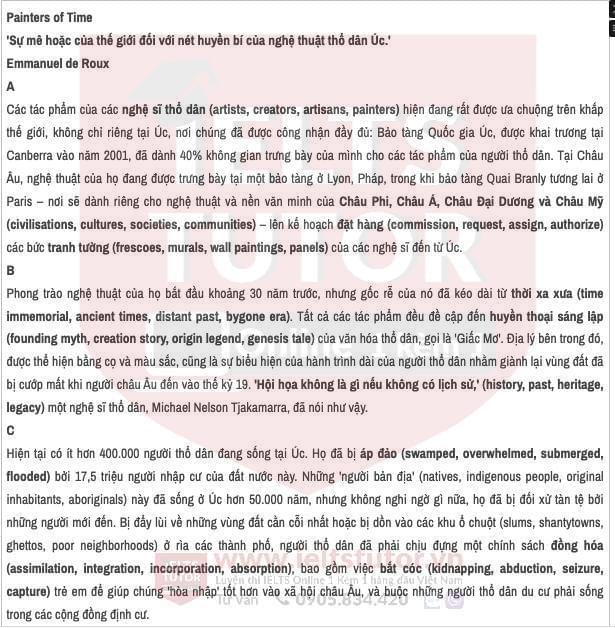



V. Giải thích từ vựng Painters of Time
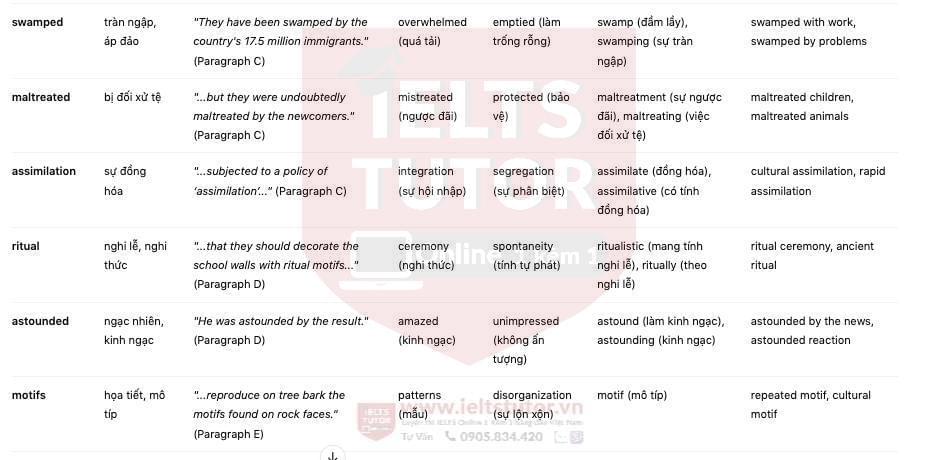
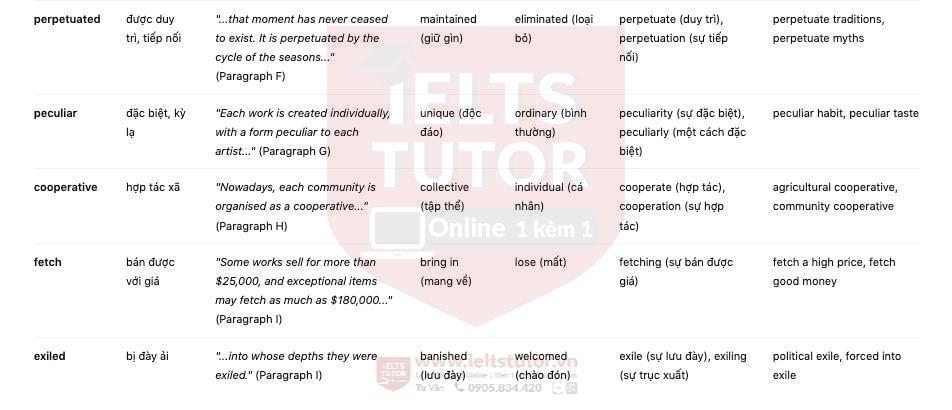

VI. Giải thích cấu trúc ngữ pháp khó Painters of Time


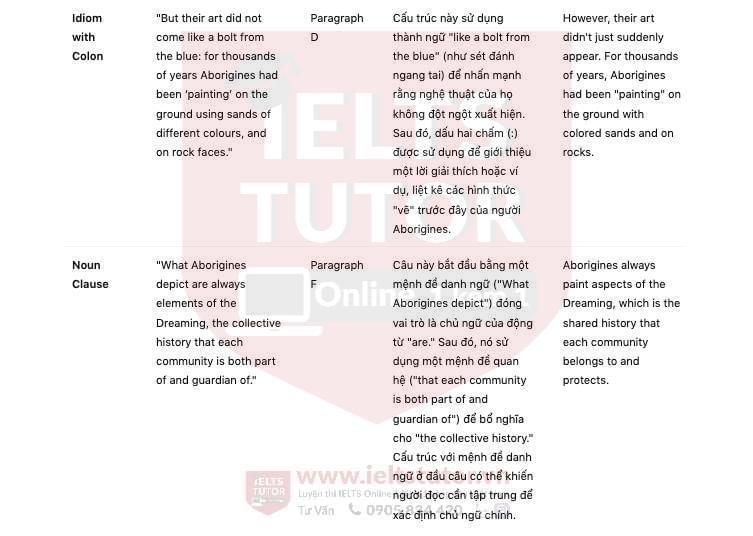
VII. Đáp án Painters of Time
vi
v
viii
i
iv
vii
thousands of years
tree bark
overseas museums
school walls
B
D
C
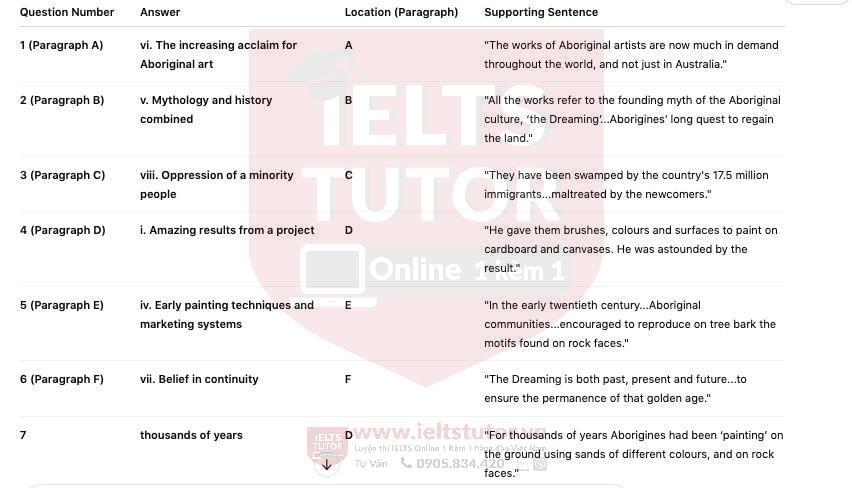
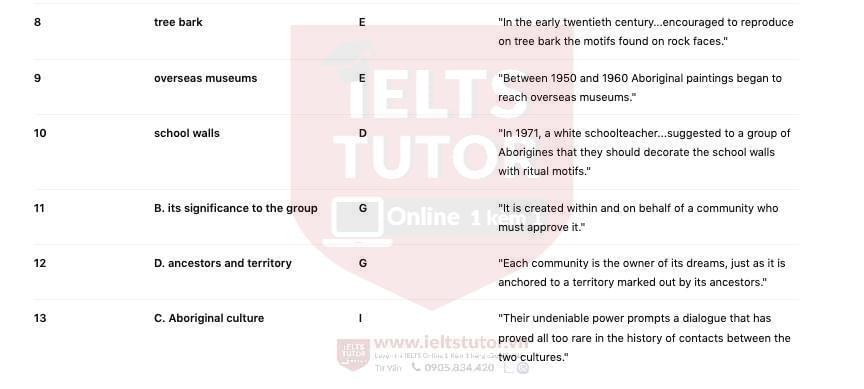

Các khóa học IELTS online 1 kèm 1 - 100% cam kết đạt target 6.0 - 7.0 - 8.0 - Đảm bảo đầu ra - Thi không đạt, học lại FREE
>> Thành tích học sinh IELTS TUTOR với hàng ngàn feedback được cập nhật hàng ngày
